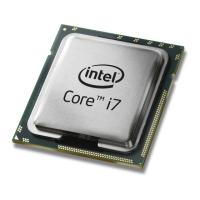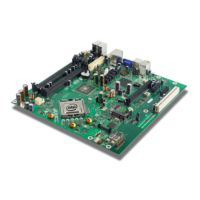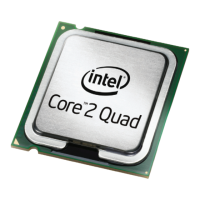Power Management
52 Datasheet, Volume 1
4.2.4.6 C-State Auto-Demotion
In general, deeper C-states such as C6 or C7 have long latencies and have higher
energy entry/exit costs. The resulting performance and energy penalties become
significant when the entry/exit frequency of a deeper C-state is high. Therefore,
incorrect or inefficient usage of deeper C-states have a negative impact on battery life
idle. To increase residency and improve battery life idle in deeper C-states, the
processor supports C-state auto-demotion.
There are two C-State auto-demotion options:
• C7/C6 to C3
• C7/C6/C3 To C1
The decision to demote a core from C6/C7 to C3 or C3/C6/C7 to C1 is based on each
core’s immediate residency history. Upon each core C6/C7 request, the core C-state is
demoted to C3 or C1 until a sufficient amount of residency has been established. At
that point, a core is allowed to go into C3/C6 or C7. Each option can be run
concurrently or individually.
This feature is disabled by default. BIOS must enable it in the
PMG_CST_CONFIG_CONTROL register. The auto-demotion policy is also configured by
this register.
4.2.5 Package C-States
The processor supports C0, C1/C1E, C3, C6, and C7 power states. The following is a
summary of the general rules for package C-state entry. These apply to all package C-
states unless specified otherwise:
• A package C-state request is determined by the lowest numerical core C-state
amongst all cores.
• A package C-state is automatically resolved by the processor depending on the
core idle power states and the status of the platform components.
— Each core can be at a lower idle power state than the package if the platform
does not grant the processor permission to enter a requested package C-state.
— The platform may allow additional power savings to be realized in the
processor.
— For package C-states, the processor is not required to enter C0 before entering
any other C-state.
The processor exits a package C-state when a break event is detected. Depending on
the type of break event, the processor does the following:
• If a core break event is received, the target core is activated and the break event
message is forwarded to the target core.
— If the break event is not masked, the target core enters the core C0 state and
the processor enters package C0.
• If the break event was due to a memory access or snoop request.
— But the platform did not request to keep the processor in a higher package C-
state, the package returns to its previous C-state.
— And the platform requests a higher power C-state, the memory access or snoop
request is serviced and the package remains in the higher power C-state.

